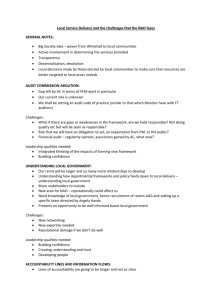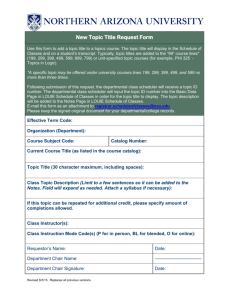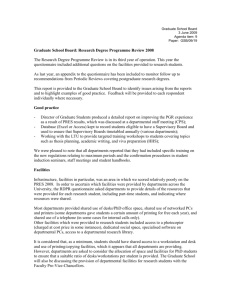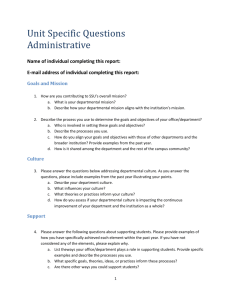Communications plan
advertisement
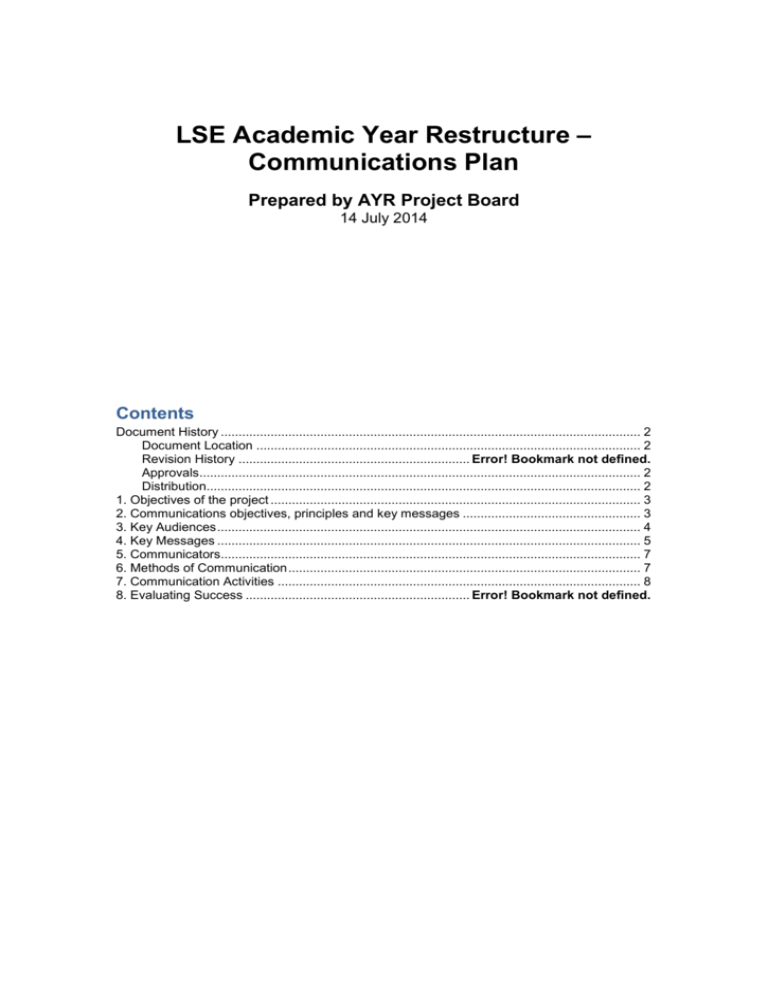
LSE Academic Year Restructure – Communications Plan Prepared by AYR Project Board 14 July 2014 Contents Document History ...................................................................................................................... 2 Document Location ............................................................................................................ 2 Revision History ................................................................. Error! Bookmark not defined. Approvals............................................................................................................................ 2 Distribution.......................................................................................................................... 2 1. Objectives of the project ........................................................................................................ 3 2. Communications objectives, principles and key messages .................................................. 3 3. Key Audiences ....................................................................................................................... 4 4. Key Messages ....................................................................................................................... 5 5. Communicators...................................................................................................................... 7 6. Methods of Communication ................................................................................................... 7 7. Communication Activities ...................................................................................................... 8 8. Evaluating Success ............................................................... Error! Bookmark not defined. Document History Document Location The source of the document can be found in: P:\ARD\TQARO\Academic Year project\Project board\2.mtg.14.7.14 Date of this version: 14.7.14, version 1 Approvals This document requires the following approvals Name Paul Kelly Signature Title Pro-Director (Teaching and Learning) Date of Issue 14.7.14 Version 1 Distribution This document has been distributed to: Name Project Board members Date of Issue 14.7.14 Version 1 Page 2 of 9 1. Project board objectives A short summary/statement of the project objectives. The project board objectives for the ‘academic year restructure’ project are: 1. To meet regularly to oversee the arrangements for implementing the new academic year structure for the 2015/16 academic year. 2. To recalibrate central and departmental services and operations for which members have responsibility, as necessary. 3. To identify necessary amendments to School regulations, and to propose changes to the ProDirector Teaching and Learning, the Academic Registrar and Director of Academic Services and to relevant School bodies. 4. To identify ‘policy gaps’ the new academic year structure creates, and to propose options to the project executive and to relevant School bodies for filling them. 5. To communicate developments to members’ service areas, to facilitate planning at local level; to develop a communications strategy for communicating changes to the student body and to School staff. 6. To identify central and departmental transitional and recurrent resource requirements. 2. Communications objectives, principles and key messages A clear statement of the objectives in communicating, the principles underpinning this strategy and your key messages. 1. To ensure that academic staff are engaged with the process of implementing the academic year structure. This involves keeping them informed of implementation developments, as necessary, and providing departments with a clear schedule for the decisions the project board needs from them to enable the implementation process, e.g. how individual departments will organise the extra term-time week; whether individual departments will make use of the Lent Term ‘Week 0’ exam period, etc. Key message: Implementation requires departmental input, for which they will need to organise their internal consultation and decision-making arrangements. 2. To ensure that departmental professional services staff are engaged with the process of implementing the new academic year structure. This involves keeping them informed of implementation developments, as necessary; ensuring they have enough information to organise and schedule the departmental input the project board needs to enable the implementation process, including identifying any resource needs. Key message: Professional services staff in departments need to identify developments of local services and procedures, and any resources required for those developments, in liaison with the project board. 3. To ensure that central professional services staff are engaged with the process of implementing the new academic year structure. This involves keeping them informed of implementation developments, as necessary; ensuring they have enough information to organise and schedule the input from specific service areas the project board needs to enable the implementation process, including identifying any resource needs. Key message: Central professional services staff need to identify developments of local services and Page 3 of 9 procedures, and any resources required for those developments, in liaison with the project board. 4. To ensure that students are kept informed of implementation developments, as necessary; that individual students are clear on what to expect from their learning experiences under the new academic year structure; and that they are clear on when they are required to be in attendance at the School under the new academic year structure. Key message: Clarify for students the changes in their learning experience and timing of attendance at the School. 5. To manage expectations among the stakeholders at 1-4 above. The project team aims to build a reputation as a trusted, quality information source which operates on a ‘no surprises’ basis across the School community. It will provide timely and accurate information to stakeholders. Key message: Project board responsible for providing details about the new academic year structure at key stages of implementation. 6. To ensure that stakeholders have the opportunity to provide input to and feedback on the design of the implementation, to raise issues, and to use their expertise to contribute to the success of the project. Key message: All input is valuable. The responsibility for the success or failure of the project is shared amongst all stakeholders. 7. To ensure that revised services and procedures are embedded in the implementation process so that the benefit of these revisions are sustained in the long term. Key messages: Thank you! You have succeeded! Implementation has been achieved; we will monitor any temporary transitional arrangements; and make further improvements based on stakeholder feedback and other evidence. 3. Key Audiences Who are you communicating with – a detailed description of your key audience and user groups. What are your priorities? Audience Approach [list as many groups as you can identify, move them under the correct heading, remove and add as required] [general mode and content of communication] Responsibility [person or role] Influencers HoDs Meetings, emails, reports PK, MTT Students’ Union Meetings, emails, presentations, social media, websites Student reps, MTT Departmental Managers Meetings, emails, websites MTT, project board members Anyone else? Page 4 of 9 Directly Impacted Students Emails, social media, websites, print media (?) PK, student reps, MTT Academic staff Email, departmental meetings, websites PK, MTT, project board members Departmental professional services staff Email, departmental meetings, websites, social media (?) MTT, project board members Central professional services staff Email, departmental meetings, websites, social media (?) MTT, project board members Part-time contract staff Email, departmental meetings, websites, social media (?) Anyone else? Input or Support Required Academic departments (including professional services staff) Email, departmental meetings, websites, social media (?) PK, MTT, project board members Central services Email, departmental meetings, websites, social media (?) MTT, project board members Students’ Union Email, departmental meetings, websites, social media (?) MTT, student reps Anyone else? Indirectly Impacted Are there any School communities who are not directly impacted by this change? 4. Key Messages What messages are you communicating – a detailed description of your key messages in order to achieve the desired communications objectives. 4.1 Project Objectives, Scope, Vision Restructured academic year will lead to improved student learning experiences by a) delivering the same volume of teaching over longer Michaelmas and Lent Terms, and b) shortening the over-long Summer Term. The additional term-time weeks allow for the possibility of reading weeks and/or additional student learning activities. The new Lent Term ‘Week 0’ exam period allows MT half-units to be examined at a time more proximate to the course teaching where departments determine that there is pedagogic merit in doing so. There are corollary benefits for some of the School’s ancillary teaching functions, e.g. timing of the Summer School. Page 5 of 9 4.2 Stakeholder Roles Academic departments: to determine organisation of extra term-time weeks and any additional learning activities they might provide (either on their own or in collaboration with TLC); to determine whether and to what extent they will make use of the Lent Term ‘Week 0’ exam period, including the impact on their support arrangements for the exam-setting/scrutiny (and any other) processes, and any resource needs; opportunity to review assessment requirements of taught provision (e.g. use of extra termtime week for summative assessment, and associated student support arrangements). Departmental professional services staff: to support and organise departmental decisions above. Central professional services staff: to review, amend, and ensure continuity across central services in support of both academic departments and students. Students: Students’ Union to help convey information about new academic year structure to wider student body; help develop peer-topeer information sharing amongst students. 4.3 Progress Status Project board members to report developments in their areas regularly at project board meetings. Implementation action plan to be developed to co-ordinate such developments. Project board minutes and summary reports to be made to Pro-Director Teaching and Learning and to Academic Registrar & Director of Academic Services. 4.4 Issues/questions and Resolutions Stakeholders to raise implementation issues/questions with relevant project board representative, who will in turn raise them either at meetings or with the chair. Issues/questions to be escalated as appropriate to project executive, with the chair conveying resolutions to relevant board member and stakeholder and, where appropriate, more widely. 4.5 Contributing Ideas At implementation milestones – as set out in implementation action plan – project board will evaluate activity for good practice, with a view to sharing more widely amongst stakeholders, e.g. departmental innovations in assessment or reading week learning support/activities. 4.6 How To Changes to departmental and central services procedures to be recorded in updated local manuals (or current equivalent, e.g. Management Department’s wiki). School-level regulations and procedures to be revised, and stakeholders notified of amendments and of any resulting operational changes. 4.7 Business Readiness Project board to determine whether academic departments are ready for the new academic year to be implemented by i) early summer 2014 communique to departments advising that they undertake early MT work on organising the additional term-time week, and take decision on use of the LT ‘Week 0’ exam period; ii) by requesting firm responses by start of LT 2015; and iii) assessing whether responses amount to deliverable teaching offer, in terms of viability of reading week learning support/activities (e.g. Do we have enough rooms? Is TLC adequately resourced? etc), and LT ‘Week 0’ capacity and logistics. ? Separate ‘business readiness’ evaluation necessary for ‘ancillary’ teaching, e.g. Summer School, executive programme teaching (tied Page 6 of 9 up with updating the ‘space allocation’ policy)? 4.8 Thank You ? Besides writing to departments/students/people, what can we do to thank people for their help in delivering the new academic year structure? 4.9 Benefits Measures Improved results in internal teaching surveys, ISB and NSS; Positive fluctuations in student performance data; Wider variety in teaching delivery and summative assessment modes. 5. Communicators In order for communications to be effective, the right people must be delivering the message. Who the right person is depends on the message and the audience. Consider who will be the key communicators throughout the project and what each will be responsible for. Communicator Objectives & Responsibilities 5.1 Paul Kelly (project executive) Will keep ‘big picture’ of implementation process visible to e.g. DMT, HoDs, ASC and other senior School stakeholders/committees, and to student body. 5.2 Mark Thomson (project manager; project board chair) Will convey official implementation messages to and requests for information from departments, service areas and students on behalf of project board. 5.3 Project board members Will supplement official implementation messages to and requests for information from department or service area they (i.e. individual members) represent. 5.4 Students’ Union Will convey information about new academic year structure to student body; will enable peer-to-peer information sharing. 5.5 Anyone else? 6. Methods of Communication What methods of communication will be used, how often and for what purposes? 6. Email Primary mode of communication 6.1 Presentations Open to project board members to deliver presentations to their department/service area as they deem appropriate. 6.2 Website TQARO to maintain this site; project board members to advise on periodic revisions (e.g. to coincide with implementation milestones). 6.3 Reports Working group reports on supplementary activities to be made to School committees (e.g. working group on assessment); project board chair to make regular implementation ‘progress reports’ to project executive. 6.4 Newsletter Life is too short. Page 7 of 9 6.5 Flyer / Poster Possibly useful for keeping students informed. Do SU reps have a view? 6.6 Stakeholder Group Meetings Conceivable that stakeholders from a particular department or service area would benefit from ‘clarification’ meetings with relevant member of project board (which project board chair would be happy to attend), though there is a slight sense of ‘overkill’ here. 6.7 One-to-One meetings Project board chair happy to hold this, as necessary/requested. 6.8 Moodle Is it worth adding a ‘New academic year structure – what it means for you’ type information sheet on Moodle? 6.9 Facebook Is it worth creating a Facebook or Yammer page to keep stakeholders (mainly students, presumably) who prefer this mode of communication updated? Who would maintain this? 6.10 Twitter As above? 6.11 Blog Would the reach of a blog be sufficient to justify the time spent developing content for it? 6.12 Wiki Probably overkill, but views? 6.13 Sharepoint ? 6.14 Events Perhaps worth using the annual Teaching Symposium to remind attendees a) that new academic year structure is happening, and b) to consider the opportunities for teaching/assessment innovations. 7. Communication Activities Media Email Objective Communique to departments advising that they undertake early MT work on organising the additional termtime week, and take decision on use of the LT ‘Week 0’ exam period Message Frequency Delivered to: Sept, reminders shortly after start of MT HoDs, DMs Delivered by: MTT Page 8 of 9 Feedback Mechanis m Email to MTT Media Objective Message Frequency Delivered to: Delivered by: Email, social media, Student News, website Convey information about new academic year structure to wider student body Headline info about structure of new academic year, and timeline for implementation TBC by Students’ Union All students Project Board, MTT, Students' Union Email, social media, Student News, website Develop peer-topeer information sharing amongst students Headline info about structure of new academic year, and timeline for implementation MT SSLC meetings SSLC meetings Students’ Union, MTT Email Maintain visibility of implementation work, keep central services staff informed Headline info about structure of new academic year, and timeline for implementation Early MT, and updates as necessary thereafter Service leaders MTT Anything else? MTT July 2014 Page 9 of 9 Feedback Mechanis m Email to MTT

